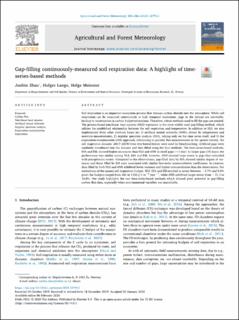| dc.description.abstract | Soil respiration is an important ecosystem process that releases carbon dioxide into the atmosphere. While soil respiration can be measured continuously at high temporal resolutions, gaps in the dataset are inevitable, leading to uncertainties in carbon budget estimations. Therefore, robust methods used to fill the gaps are needed. The process-based non-linear least squares (NLS) regression is the most widely used gap-filling method, which utilizes the established relationship between the soil respiration and temperature. In addition to NLS, we also implemented three other methods based on: 1) artificial neural networks (ANN), driven by temperature and moisture measurements, 2) singular spectrum analysis (SSA), relying only on the time series itself, and 3) the expectation-maximization (EM) approach, referencing to parallel flux measurements in the spatial vicinity. Six soil respiration datasets (2017–2019) from two boreal forests were used for benchmarking. Artificial gaps were randomly introduced into the datasets and then filled using the four methods. The time-series-based methods, SSA and EM, showed higher accuracies than NLS and ANN in small gaps (<1 day). In larger gaps (15 days), the performance was similar among NLS, SSA and EM; however, ANN showed large errors in gaps that coincided with precipitation events. Compared to the observations, gap-filled data by SSA showed similar degree of variances and those filled by EM were associated with similar first-order autocorrelation coefficients. In contrast, data filled by both NLS and ANN exhibited lower variance and higher autocorrelation than the observations. For estimations of the annual soil respiration budget, NLS, SSA and EM resulted in errors between −3.7% and 5.8% given the budgets ranged from 463 to 1152 g C m−2 year−1, while ANN exhibited larger errors from −11.3 to 16.0%. Our study highlights the two time-series-based methods which showed great potential in gap-filling carbon flux data, especially when environmental variables are unavailable. | en_US |

